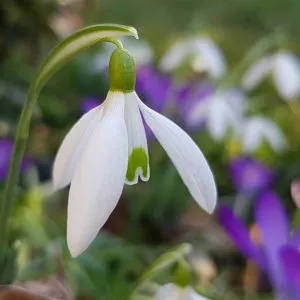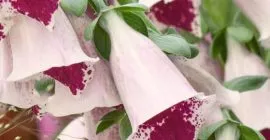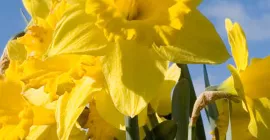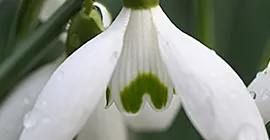With the growing interest in nature and wildlife preservation, gardeners are being encouraged to attract more wildlife species into their gardens. One way this can be done is by planting mini woodland scenes, wildflowers and natural areas within your garden. This is one of the trends that has been showcased at RHS Chelsea Flower Show 2019.
One Chelsea garden in particular that follows this growing trend, is the RHS Back to Nature garden co-designed by HRH The Duchess of Cambridge. The garden is based on a woodland setting and is designed in mind of families and communities coming together to connect with and get inspired by nature. To read more about the garden visit the RHS website
How to create a woodland flower garden

Creating your own woodland setting or natural haven in your garden is easier than you think and you don’t even need to have the largest of gardens! One of the easiest and best ways to create your very own is by planting an array of woodland, native and naturalising plants that will attract bees and other wildlife into your garden.
Woodland plants are one of the best ways to give colour and interest to areas of the garden that otherwise might not bloom. This may be due to lack of sunlight or possibly due to poor soil conditions. Many woodland plants are naturalising bulbs that naturally seed and spread after flowering, giving you a display that will certainly get better year after year.
Woodland flower varieties
There are a number of native wildflowers that thrive in a woodland setting but can also easily grow in your garden.
- Alliums are easy to grow summer flowering bulbs that add height and structure to garden beds and borders.
- Bluebells are easy to grow and you can recreate the amazing woodland bluebell carpet experience in miniature. The splash of colour lasts during April and May and thrives in partial shade under trees and shrubs. The contrast in colours look stunning when planted under silver birch trees.
- Crocuses bring colour to the garden in February and naturalise quickly to create a stunning show year after year.
- Cyclamen are mainly autumn and winter-flowering woodland varieties that flower when other flowers are absent. They look great when planted together with snowdrops and primroses.
- Daffodils are often associated as a sign of spring. Plant bulbs in autumn so they can burst into flower from February to early May. Read our how to grow Daffodils article for more advice.
- Hyacinths require very little maintenance. Plant bulbs in autumn ready for a beautiful, fragrant display the following spring.
- Snowdrops are a welcome sign that spring is on its way after the darkness and cold period that winter brings. You can create a magnificent carpet display in your own garden by planting snowdrop bulbs in late-winter for flowering in Mid-January to March. Read our article for further advice on how to grow Snowdrops.
Where to plant woodland flowers
Woodland flowers are shade loving plants that do best when planted under deciduous trees, where the conditions are too dry and shady for most plants. If you have little or no shade in your garden, try planting shrubs or adding climbing plants onto a trellis as this can create shade for diminutive spring-flowering woodlanders.
Woodland flowers can also thrive in lawns or in wildflower areas. It is best to check the optimum growing requirements on the back of seed/ bulb packet before planting.
When to plant woodland flowers
The best time to grow woodland flowers is during the autumn months (September-November) as the spring-flowering bulbs such as daffodils, crocus and hyacinths will flourish and provide colour in late winter and during spring.
How to plant woodland flowers
To create the naturalising woodland effect, allow the plants to seed and spread wherever they choose to do so. The only bulbs that will really need to be grown on their own are English bluebells as they will happily swamp anything in their path.
What you’ll need…
- Your choice of woodland flower bulbs / seeds
- Garden fork
- Hose / Watering can
Planting bulbs in beds and borders:
- When planting bulbs, first make the holes in the soil with a garden fork.
- Then pop the bulbs into the holes that you’ve just made. Make sure the holes are about 3 times the depth of the bulbs.
- Finally, simply fill the holes with both soil and water.
Planting bulbs in lawns:
- The best way to plant larger bulbs is to lift a patch of turf and scatter the bulbs.
- Score the underside of the turf to loosen the soil and then replace it.
- Give the area a good watering with the hose.
Planting woodland flowers from seed:
- Rake and break down any lumps in the soil.
- Scatter the seeds onto the area.
- Lightly rake or tread in the seed. Do not bury the seed too deep as it may hinder the germination of the seed.
Top Tips for planting woodland flowers
- Make sure you choose the right plant for the right area. You can do this by checking the growing instructions to make sure they do well in the area that you’re tending to plant in.
- If planting in lawns then choose early flowering bulbs. This will give the leaves time to die back naturally before it’s time to get the lawn mower out.
- To make a more natural appearance, scatter and plant the bulbs so they’re not planted in a neat rows. It is a good idea to make sure they’re not planted too close together as they will need room to spread and naturalise.
- Once the bulbs have finished flowering make sure you give them time to die naturally, this normally takes around a minimum of 6 weeks. This will help the bulbs to build up strength for the next growing season.




